Observing the Whole Child: Anecdotal Observations and Learning Stories
VerifiedAdded on 2023/06/15
|14
|2959
|232
AI Summary
This article discusses anecdotal observations and learning stories for observing the whole child. It includes three anecdotal observations and learning stories, linked to Early Years Learning Framework outcomes, goals, and plans to achieve them. The article aims to provide insights into the child's world and promote their development.
Contribute Materials
Your contribution can guide someone’s learning journey. Share your
documents today.
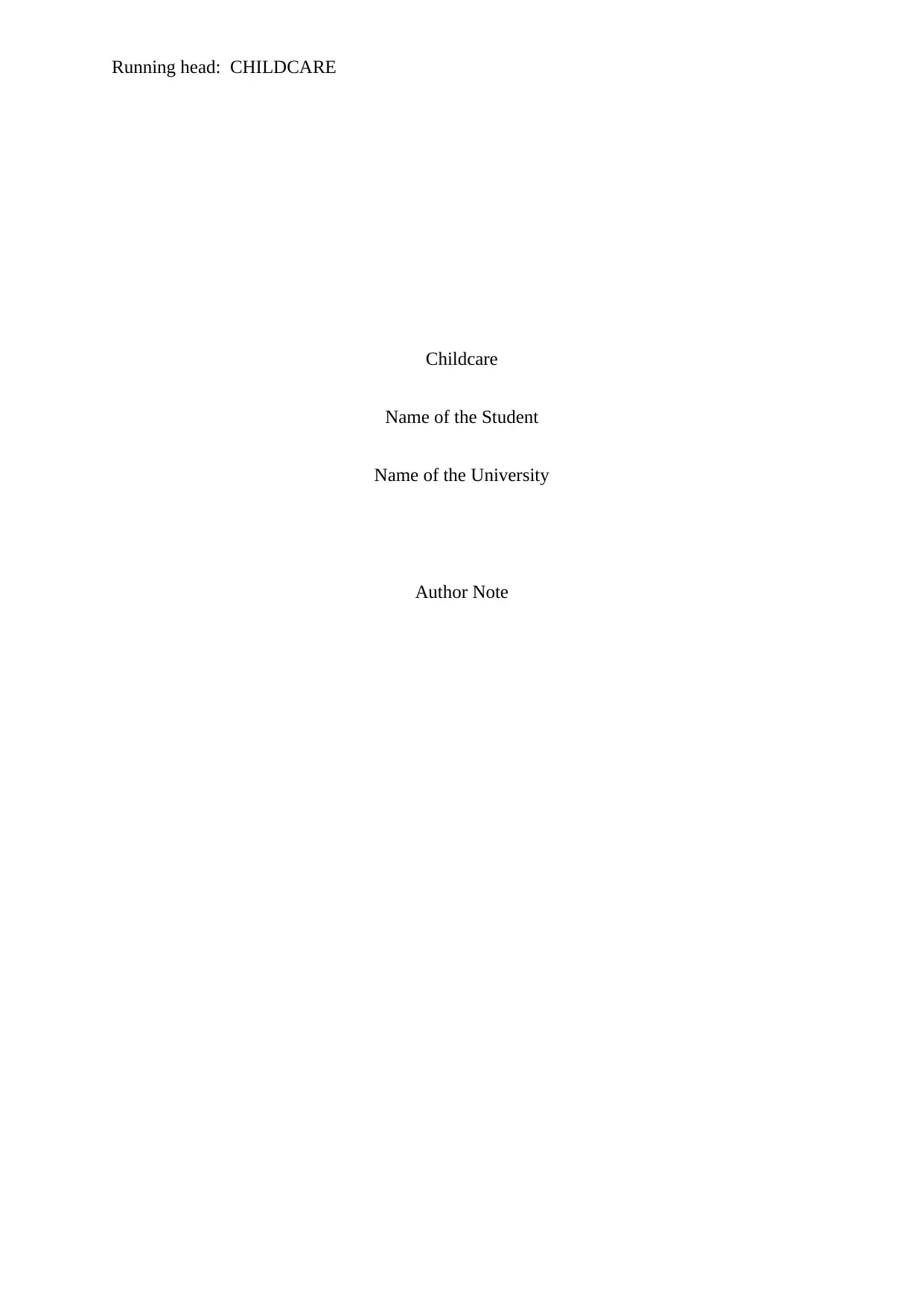
Running head: CHILDCARE
Childcare
Name of the Student
Name of the University
Author Note
Childcare
Name of the Student
Name of the University
Author Note
Secure Best Marks with AI Grader
Need help grading? Try our AI Grader for instant feedback on your assignments.
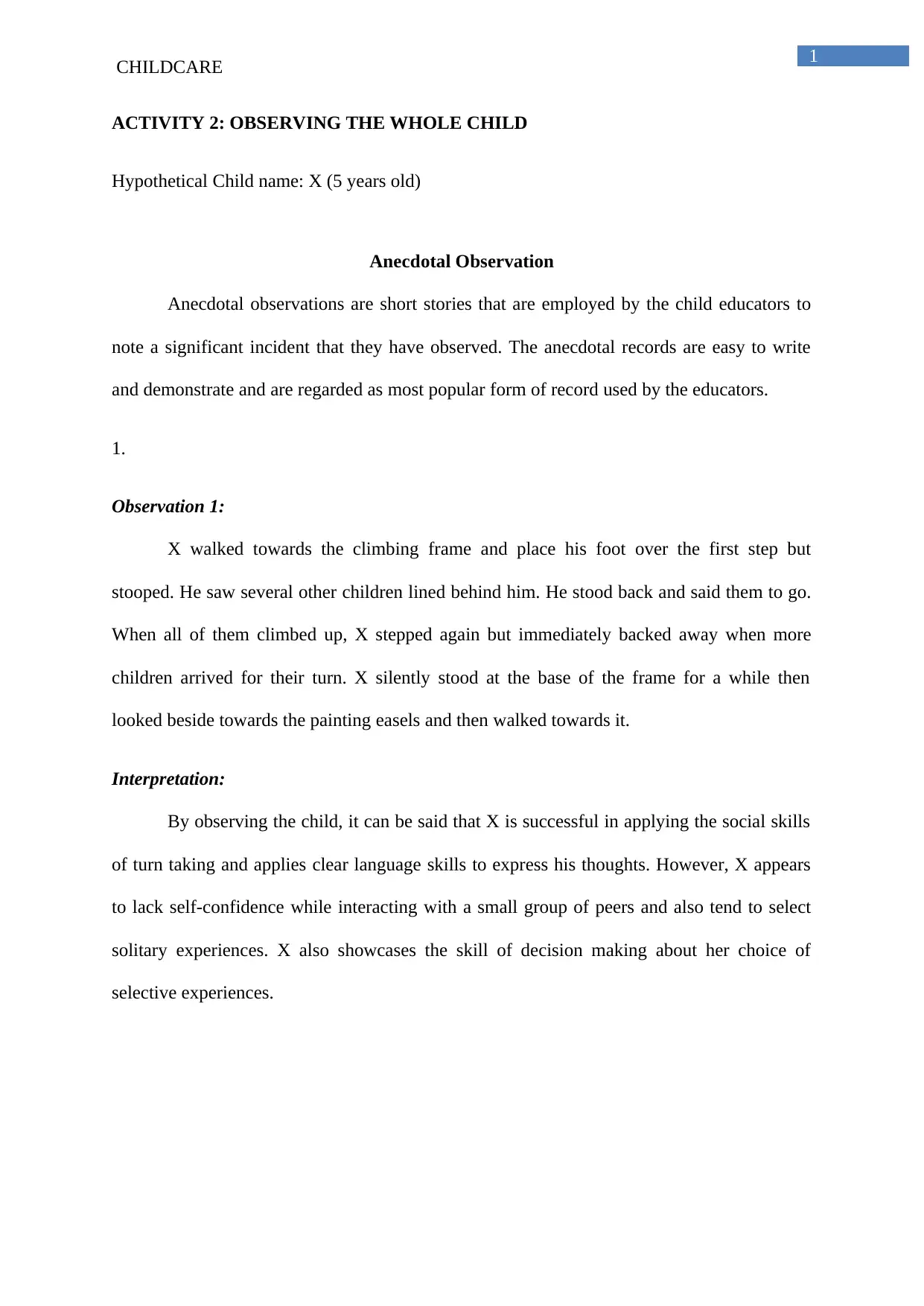
1
CHILDCARE
ACTIVITY 2: OBSERVING THE WHOLE CHILD
Hypothetical Child name: X (5 years old)
Anecdotal Observation
Anecdotal observations are short stories that are employed by the child educators to
note a significant incident that they have observed. The anecdotal records are easy to write
and demonstrate and are regarded as most popular form of record used by the educators.
1.
Observation 1:
X walked towards the climbing frame and place his foot over the first step but
stooped. He saw several other children lined behind him. He stood back and said them to go.
When all of them climbed up, X stepped again but immediately backed away when more
children arrived for their turn. X silently stood at the base of the frame for a while then
looked beside towards the painting easels and then walked towards it.
Interpretation:
By observing the child, it can be said that X is successful in applying the social skills
of turn taking and applies clear language skills to express his thoughts. However, X appears
to lack self-confidence while interacting with a small group of peers and also tend to select
solitary experiences. X also showcases the skill of decision making about her choice of
selective experiences.
CHILDCARE
ACTIVITY 2: OBSERVING THE WHOLE CHILD
Hypothetical Child name: X (5 years old)
Anecdotal Observation
Anecdotal observations are short stories that are employed by the child educators to
note a significant incident that they have observed. The anecdotal records are easy to write
and demonstrate and are regarded as most popular form of record used by the educators.
1.
Observation 1:
X walked towards the climbing frame and place his foot over the first step but
stooped. He saw several other children lined behind him. He stood back and said them to go.
When all of them climbed up, X stepped again but immediately backed away when more
children arrived for their turn. X silently stood at the base of the frame for a while then
looked beside towards the painting easels and then walked towards it.
Interpretation:
By observing the child, it can be said that X is successful in applying the social skills
of turn taking and applies clear language skills to express his thoughts. However, X appears
to lack self-confidence while interacting with a small group of peers and also tend to select
solitary experiences. X also showcases the skill of decision making about her choice of
selective experiences.

2
CHILDCARE
Link to Early Years Learning Framework outcome
The child’s observation is linked to the below mentioned Early Years Learning
Framework outcome:
Outcome 1: Children have a strong sense of identity
Outcome 3: Children have a strong sense of well-being
Goals for the child:
The following are the goals for further development of the child:
Encourage the child to engage in verbal and non-verbal communication with others
To provide support to engage in group activities with others
To explore her level of self-confidence and sense of personal well-being
Plans to meet the goals in the future
This goal can be achieved via engaging X in enjoyable interaction via employing both
verbal and non-verbal language. This will help in building of confidence among X. The
communication must be initiated first among the closed peers and then with among the peers
with who lies within the wider circumference This will be helpful for X because in sustained
communication with the children about creative and engaging ideas and experiences will help
to increase the horizon of their vocabulary and thereby helping them to gain confidence while
interacting with others in groups.
2.
Observation 2:
X was sitting inside a sandbox. In front of him there was a pie pan and he was holding
a wooden spoon in his right hand. He slowly scooped up sand with spoon and dumped it
CHILDCARE
Link to Early Years Learning Framework outcome
The child’s observation is linked to the below mentioned Early Years Learning
Framework outcome:
Outcome 1: Children have a strong sense of identity
Outcome 3: Children have a strong sense of well-being
Goals for the child:
The following are the goals for further development of the child:
Encourage the child to engage in verbal and non-verbal communication with others
To provide support to engage in group activities with others
To explore her level of self-confidence and sense of personal well-being
Plans to meet the goals in the future
This goal can be achieved via engaging X in enjoyable interaction via employing both
verbal and non-verbal language. This will help in building of confidence among X. The
communication must be initiated first among the closed peers and then with among the peers
with who lies within the wider circumference This will be helpful for X because in sustained
communication with the children about creative and engaging ideas and experiences will help
to increase the horizon of their vocabulary and thereby helping them to gain confidence while
interacting with others in groups.
2.
Observation 2:
X was sitting inside a sandbox. In front of him there was a pie pan and he was holding
a wooden spoon in his right hand. He slowly scooped up sand with spoon and dumped it
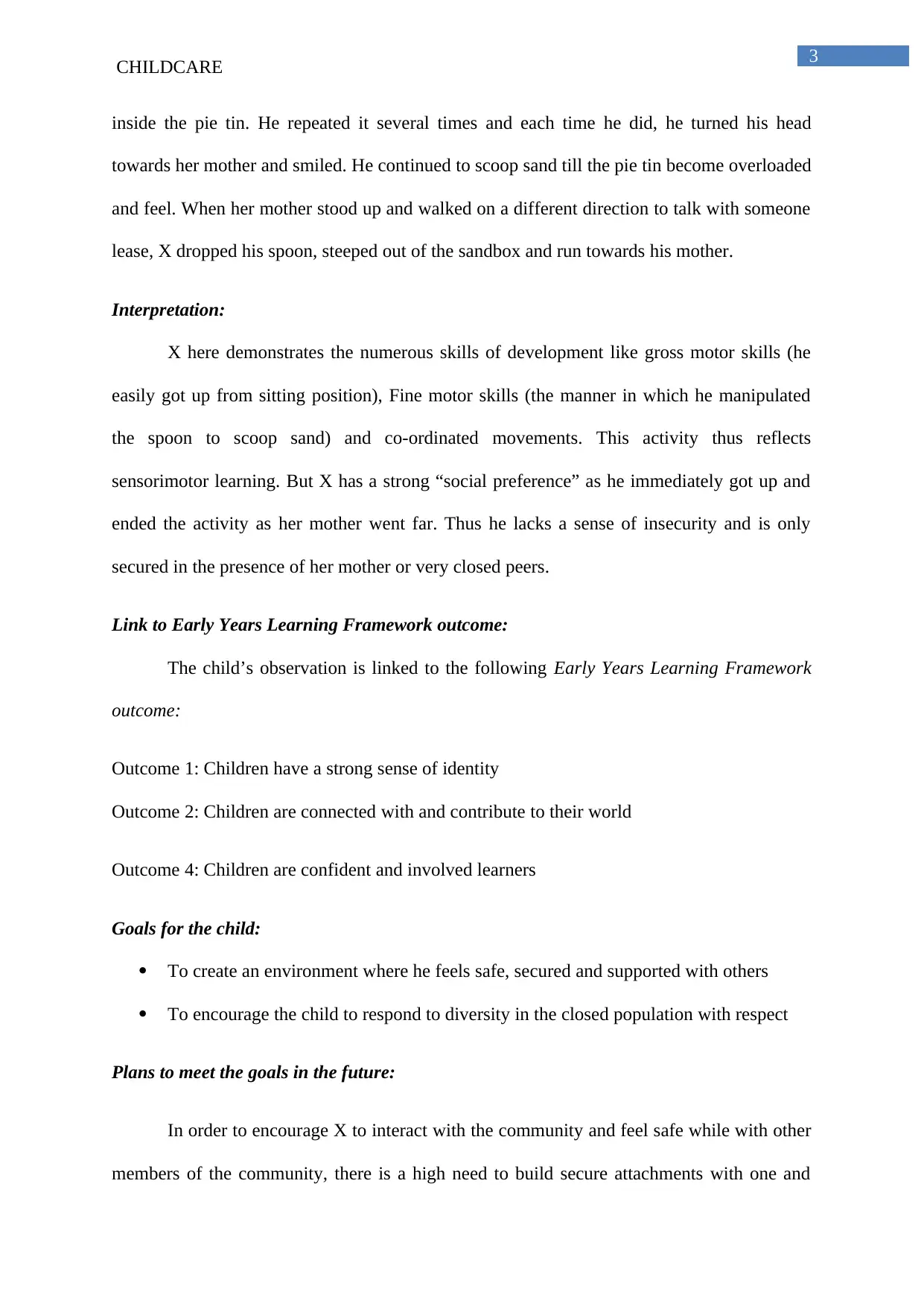
3
CHILDCARE
inside the pie tin. He repeated it several times and each time he did, he turned his head
towards her mother and smiled. He continued to scoop sand till the pie tin become overloaded
and feel. When her mother stood up and walked on a different direction to talk with someone
lease, X dropped his spoon, steeped out of the sandbox and run towards his mother.
Interpretation:
X here demonstrates the numerous skills of development like gross motor skills (he
easily got up from sitting position), Fine motor skills (the manner in which he manipulated
the spoon to scoop sand) and co-ordinated movements. This activity thus reflects
sensorimotor learning. But X has a strong “social preference” as he immediately got up and
ended the activity as her mother went far. Thus he lacks a sense of insecurity and is only
secured in the presence of her mother or very closed peers.
Link to Early Years Learning Framework outcome:
The child’s observation is linked to the following Early Years Learning Framework
outcome:
Outcome 1: Children have a strong sense of identity
Outcome 2: Children are connected with and contribute to their world
Outcome 4: Children are confident and involved learners
Goals for the child:
To create an environment where he feels safe, secured and supported with others
To encourage the child to respond to diversity in the closed population with respect
Plans to meet the goals in the future:
In order to encourage X to interact with the community and feel safe while with other
members of the community, there is a high need to build secure attachments with one and
CHILDCARE
inside the pie tin. He repeated it several times and each time he did, he turned his head
towards her mother and smiled. He continued to scoop sand till the pie tin become overloaded
and feel. When her mother stood up and walked on a different direction to talk with someone
lease, X dropped his spoon, steeped out of the sandbox and run towards his mother.
Interpretation:
X here demonstrates the numerous skills of development like gross motor skills (he
easily got up from sitting position), Fine motor skills (the manner in which he manipulated
the spoon to scoop sand) and co-ordinated movements. This activity thus reflects
sensorimotor learning. But X has a strong “social preference” as he immediately got up and
ended the activity as her mother went far. Thus he lacks a sense of insecurity and is only
secured in the presence of her mother or very closed peers.
Link to Early Years Learning Framework outcome:
The child’s observation is linked to the following Early Years Learning Framework
outcome:
Outcome 1: Children have a strong sense of identity
Outcome 2: Children are connected with and contribute to their world
Outcome 4: Children are confident and involved learners
Goals for the child:
To create an environment where he feels safe, secured and supported with others
To encourage the child to respond to diversity in the closed population with respect
Plans to meet the goals in the future:
In order to encourage X to interact with the community and feel safe while with other
members of the community, there is a high need to build secure attachments with one and
Secure Best Marks with AI Grader
Need help grading? Try our AI Grader for instant feedback on your assignments.

4
CHILDCARE
then with more familiar educators. This will be done via the effective routines in order to
make the predicted transition smooth. In order increase his sense of security with other, the
child must be planned to get involved in group activities or team games under the supervision
with other seniors apart from his parents so that get accustomed with the company with
others and learn the skills of engaging in group activities.
3.
Observation 3:
The child X (5 years old) decided to have coffee in the garden. She was
talking to herself regarding what she needed for her coffee table and invited me too. She
pulled out a red table and arranged flowers and cups. She changed the table arrangements
three times. She pretended to drink and asked me whether I would like some cake. She also
made short conversations regarding the shopping she did last day and the store from which
she bought some cloths.
Interpretation:
By observing the child, it can be interpreted that she is an active learner and has good sense
of her environment. The way she pretends to have a coffee and arrange her coffee table
reflects she is connected to the world and closely observes daily things that happen around
her. She was imitating just like her parents do on coffee table. Her shopping conversation
shows that she has strong sense of identity too. It is related to the social and cognitive
developmental areas.
Link to Early Years Learning Framework outcome:
The child’s observation is linked to the following Early Years Learning Framework
outcome:
CHILDCARE
then with more familiar educators. This will be done via the effective routines in order to
make the predicted transition smooth. In order increase his sense of security with other, the
child must be planned to get involved in group activities or team games under the supervision
with other seniors apart from his parents so that get accustomed with the company with
others and learn the skills of engaging in group activities.
3.
Observation 3:
The child X (5 years old) decided to have coffee in the garden. She was
talking to herself regarding what she needed for her coffee table and invited me too. She
pulled out a red table and arranged flowers and cups. She changed the table arrangements
three times. She pretended to drink and asked me whether I would like some cake. She also
made short conversations regarding the shopping she did last day and the store from which
she bought some cloths.
Interpretation:
By observing the child, it can be interpreted that she is an active learner and has good sense
of her environment. The way she pretends to have a coffee and arrange her coffee table
reflects she is connected to the world and closely observes daily things that happen around
her. She was imitating just like her parents do on coffee table. Her shopping conversation
shows that she has strong sense of identity too. It is related to the social and cognitive
developmental areas.
Link to Early Years Learning Framework outcome:
The child’s observation is linked to the following Early Years Learning Framework
outcome:

5
CHILDCARE
Outcome 1: Children have a strong sense of identity
Outcome 2: Children are connected with and contribute to their world
Goals for the child:
The following are the goals for further development of the child:
To create an environment where the child learns to respect her relationship and
environment
To provide her opportunities for engaging in collaborative work
To further explore child decision making skills
Plans to meet the goals in the future:
To expose the child to her community and environment, dramatic play can be
arranged where she will be asked to mimic her parents and the work they do for her. Doing
such acts will support the child to express her feelings and thoughts and she can be taught to
respect her relationships. Her decision making skills and collaborative work skills can be
explored in group based activity where the group may be asked to make a sand house or toy.
This will enhance her decision making as well as collaborative skills to make her independent
in later lives.
Photo observation with narratives and analysis
Child observation:
CHILDCARE
Outcome 1: Children have a strong sense of identity
Outcome 2: Children are connected with and contribute to their world
Goals for the child:
The following are the goals for further development of the child:
To create an environment where the child learns to respect her relationship and
environment
To provide her opportunities for engaging in collaborative work
To further explore child decision making skills
Plans to meet the goals in the future:
To expose the child to her community and environment, dramatic play can be
arranged where she will be asked to mimic her parents and the work they do for her. Doing
such acts will support the child to express her feelings and thoughts and she can be taught to
respect her relationships. Her decision making skills and collaborative work skills can be
explored in group based activity where the group may be asked to make a sand house or toy.
This will enhance her decision making as well as collaborative skills to make her independent
in later lives.
Photo observation with narratives and analysis
Child observation:
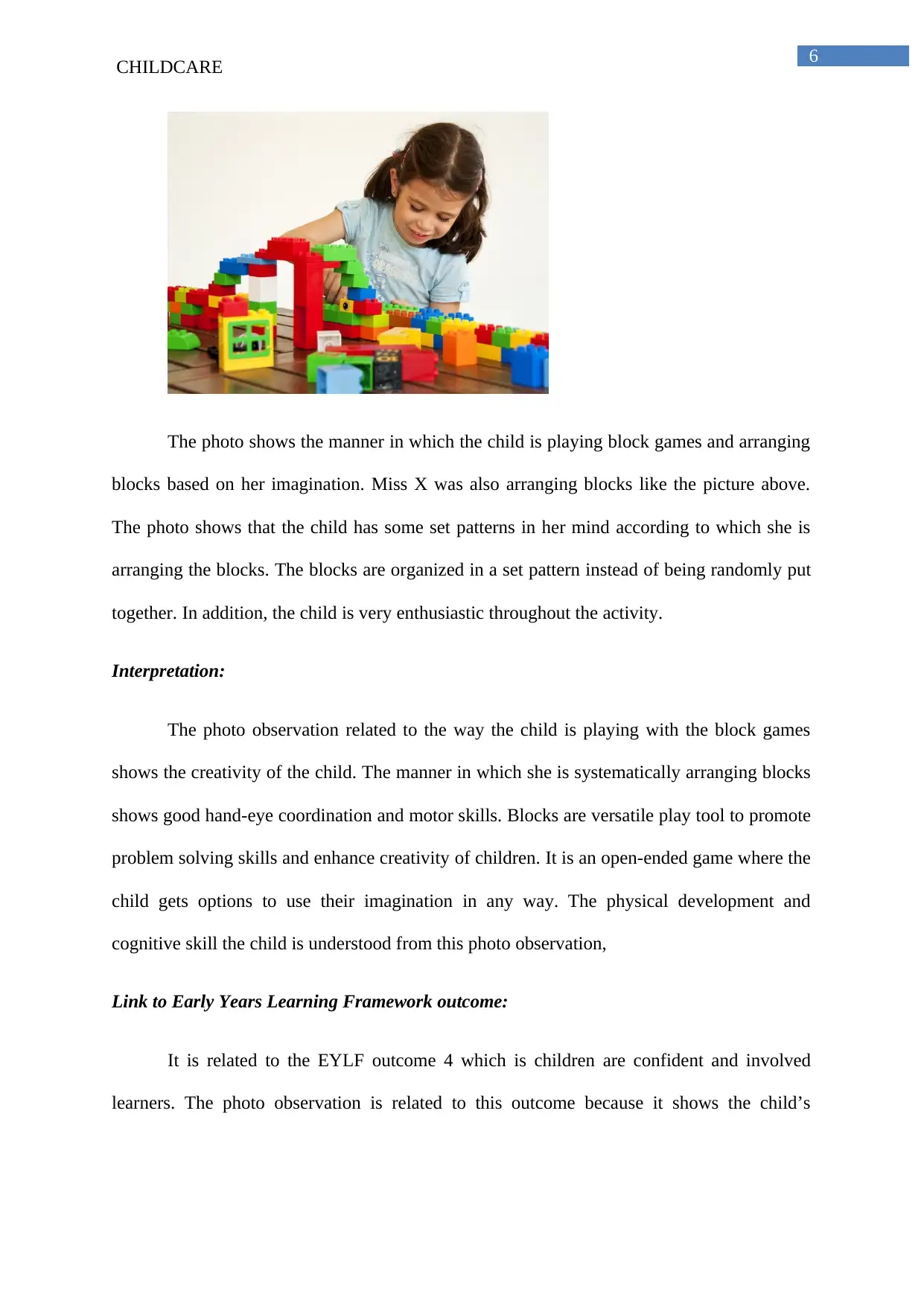
6
CHILDCARE
The photo shows the manner in which the child is playing block games and arranging
blocks based on her imagination. Miss X was also arranging blocks like the picture above.
The photo shows that the child has some set patterns in her mind according to which she is
arranging the blocks. The blocks are organized in a set pattern instead of being randomly put
together. In addition, the child is very enthusiastic throughout the activity.
Interpretation:
The photo observation related to the way the child is playing with the block games
shows the creativity of the child. The manner in which she is systematically arranging blocks
shows good hand-eye coordination and motor skills. Blocks are versatile play tool to promote
problem solving skills and enhance creativity of children. It is an open-ended game where the
child gets options to use their imagination in any way. The physical development and
cognitive skill the child is understood from this photo observation,
Link to Early Years Learning Framework outcome:
It is related to the EYLF outcome 4 which is children are confident and involved
learners. The photo observation is related to this outcome because it shows the child’s
CHILDCARE
The photo shows the manner in which the child is playing block games and arranging
blocks based on her imagination. Miss X was also arranging blocks like the picture above.
The photo shows that the child has some set patterns in her mind according to which she is
arranging the blocks. The blocks are organized in a set pattern instead of being randomly put
together. In addition, the child is very enthusiastic throughout the activity.
Interpretation:
The photo observation related to the way the child is playing with the block games
shows the creativity of the child. The manner in which she is systematically arranging blocks
shows good hand-eye coordination and motor skills. Blocks are versatile play tool to promote
problem solving skills and enhance creativity of children. It is an open-ended game where the
child gets options to use their imagination in any way. The physical development and
cognitive skill the child is understood from this photo observation,
Link to Early Years Learning Framework outcome:
It is related to the EYLF outcome 4 which is children are confident and involved
learners. The photo observation is related to this outcome because it shows the child’s
Paraphrase This Document
Need a fresh take? Get an instant paraphrase of this document with our AI Paraphraser
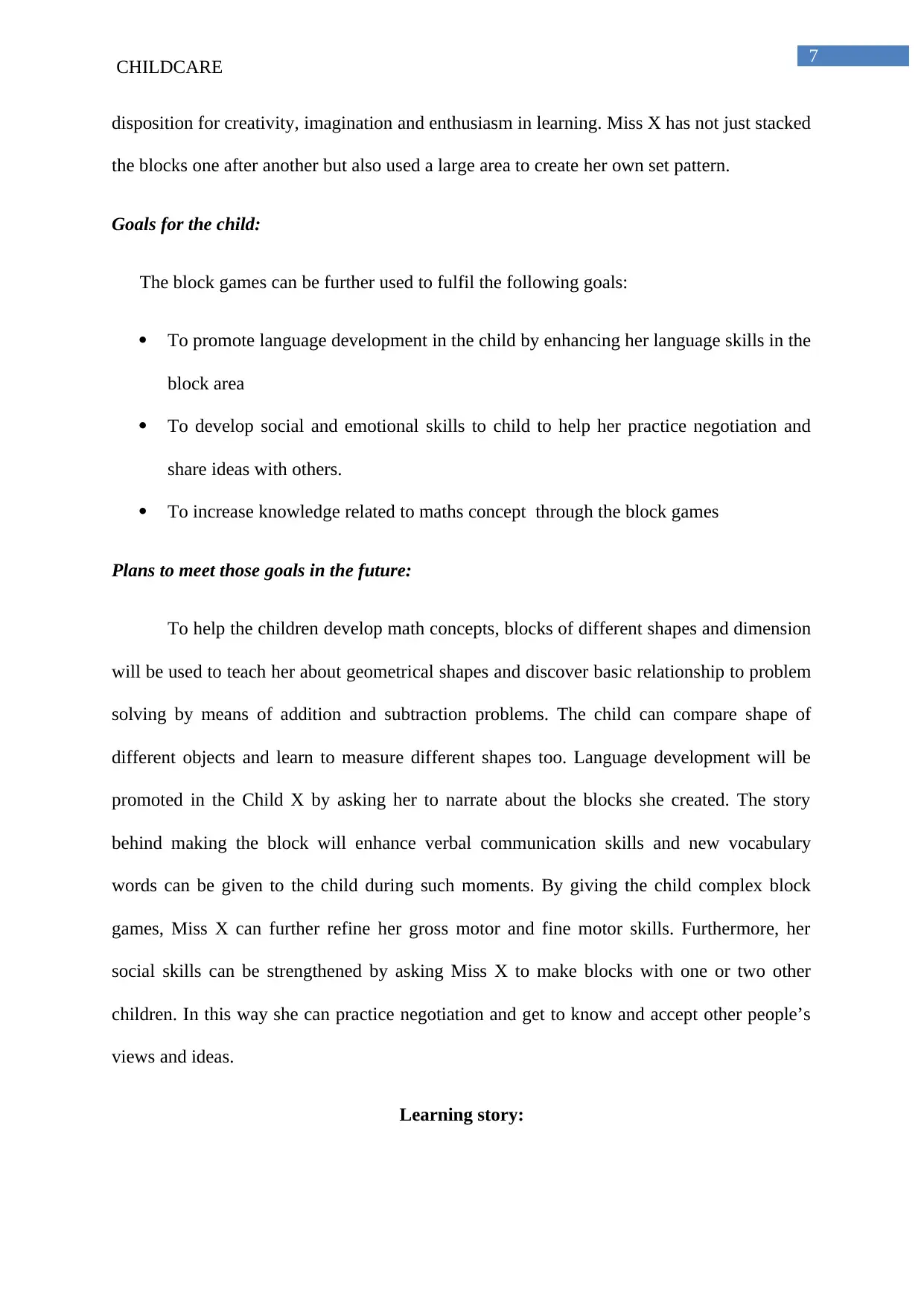
7
CHILDCARE
disposition for creativity, imagination and enthusiasm in learning. Miss X has not just stacked
the blocks one after another but also used a large area to create her own set pattern.
Goals for the child:
The block games can be further used to fulfil the following goals:
To promote language development in the child by enhancing her language skills in the
block area
To develop social and emotional skills to child to help her practice negotiation and
share ideas with others.
To increase knowledge related to maths concept through the block games
Plans to meet those goals in the future:
To help the children develop math concepts, blocks of different shapes and dimension
will be used to teach her about geometrical shapes and discover basic relationship to problem
solving by means of addition and subtraction problems. The child can compare shape of
different objects and learn to measure different shapes too. Language development will be
promoted in the Child X by asking her to narrate about the blocks she created. The story
behind making the block will enhance verbal communication skills and new vocabulary
words can be given to the child during such moments. By giving the child complex block
games, Miss X can further refine her gross motor and fine motor skills. Furthermore, her
social skills can be strengthened by asking Miss X to make blocks with one or two other
children. In this way she can practice negotiation and get to know and accept other people’s
views and ideas.
Learning story:
CHILDCARE
disposition for creativity, imagination and enthusiasm in learning. Miss X has not just stacked
the blocks one after another but also used a large area to create her own set pattern.
Goals for the child:
The block games can be further used to fulfil the following goals:
To promote language development in the child by enhancing her language skills in the
block area
To develop social and emotional skills to child to help her practice negotiation and
share ideas with others.
To increase knowledge related to maths concept through the block games
Plans to meet those goals in the future:
To help the children develop math concepts, blocks of different shapes and dimension
will be used to teach her about geometrical shapes and discover basic relationship to problem
solving by means of addition and subtraction problems. The child can compare shape of
different objects and learn to measure different shapes too. Language development will be
promoted in the Child X by asking her to narrate about the blocks she created. The story
behind making the block will enhance verbal communication skills and new vocabulary
words can be given to the child during such moments. By giving the child complex block
games, Miss X can further refine her gross motor and fine motor skills. Furthermore, her
social skills can be strengthened by asking Miss X to make blocks with one or two other
children. In this way she can practice negotiation and get to know and accept other people’s
views and ideas.
Learning story:
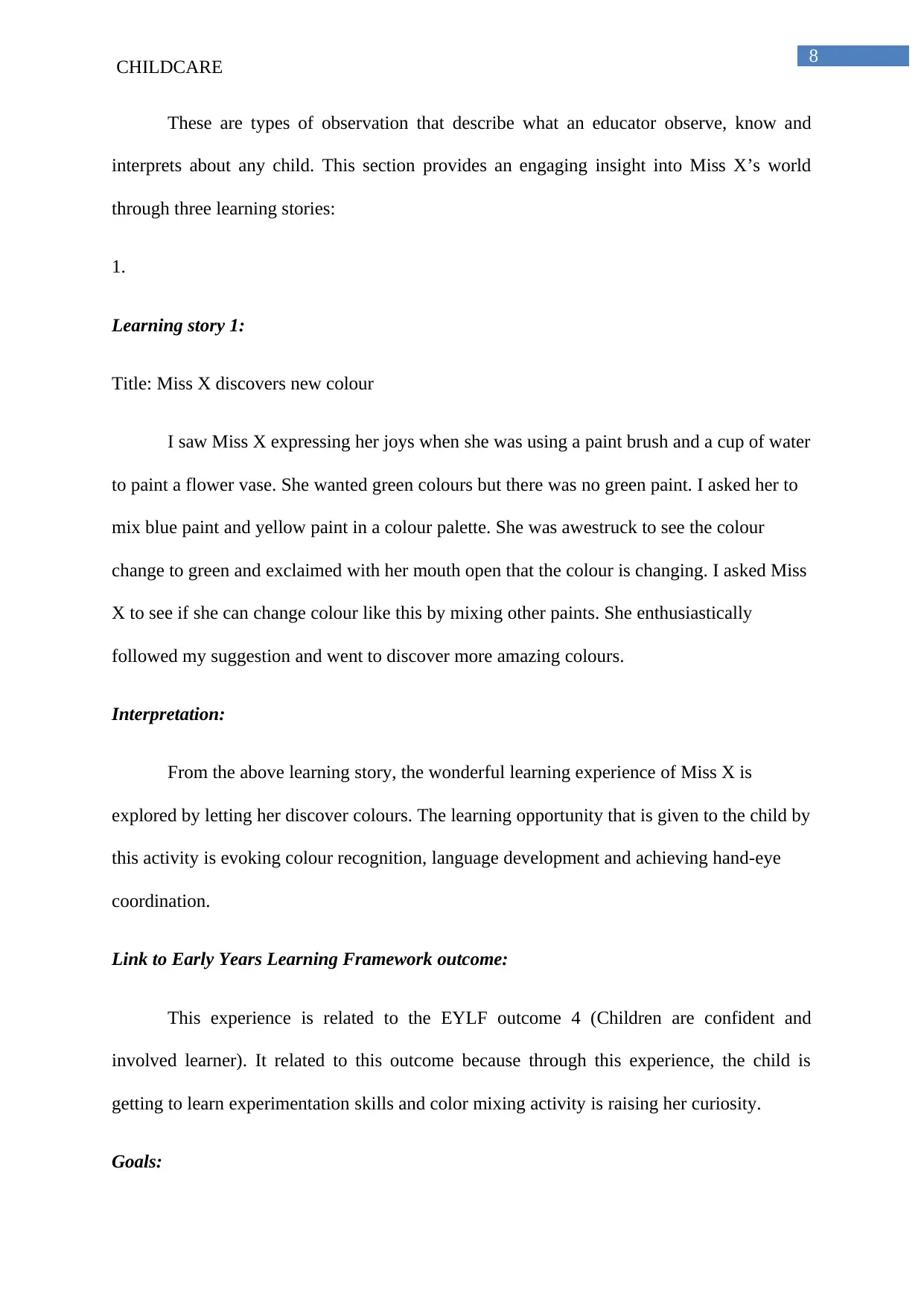
8
CHILDCARE
These are types of observation that describe what an educator observe, know and
interprets about any child. This section provides an engaging insight into Miss X’s world
through three learning stories:
1.
Learning story 1:
Title: Miss X discovers new colour
I saw Miss X expressing her joys when she was using a paint brush and a cup of water
to paint a flower vase. She wanted green colours but there was no green paint. I asked her to
mix blue paint and yellow paint in a colour palette. She was awestruck to see the colour
change to green and exclaimed with her mouth open that the colour is changing. I asked Miss
X to see if she can change colour like this by mixing other paints. She enthusiastically
followed my suggestion and went to discover more amazing colours.
Interpretation:
From the above learning story, the wonderful learning experience of Miss X is
explored by letting her discover colours. The learning opportunity that is given to the child by
this activity is evoking colour recognition, language development and achieving hand-eye
coordination.
Link to Early Years Learning Framework outcome:
This experience is related to the EYLF outcome 4 (Children are confident and
involved learner). It related to this outcome because through this experience, the child is
getting to learn experimentation skills and color mixing activity is raising her curiosity.
Goals:
CHILDCARE
These are types of observation that describe what an educator observe, know and
interprets about any child. This section provides an engaging insight into Miss X’s world
through three learning stories:
1.
Learning story 1:
Title: Miss X discovers new colour
I saw Miss X expressing her joys when she was using a paint brush and a cup of water
to paint a flower vase. She wanted green colours but there was no green paint. I asked her to
mix blue paint and yellow paint in a colour palette. She was awestruck to see the colour
change to green and exclaimed with her mouth open that the colour is changing. I asked Miss
X to see if she can change colour like this by mixing other paints. She enthusiastically
followed my suggestion and went to discover more amazing colours.
Interpretation:
From the above learning story, the wonderful learning experience of Miss X is
explored by letting her discover colours. The learning opportunity that is given to the child by
this activity is evoking colour recognition, language development and achieving hand-eye
coordination.
Link to Early Years Learning Framework outcome:
This experience is related to the EYLF outcome 4 (Children are confident and
involved learner). It related to this outcome because through this experience, the child is
getting to learn experimentation skills and color mixing activity is raising her curiosity.
Goals:

9
CHILDCARE
The following are the goals for the development of Miss X:
To further explore ideas and theories by means of creative plays like painting
To help the child make connections with real life experiences and promote scientific
thinking
To promote language development in the child
Plans to achieve the goal in the future:
To achieve the above mentioned goals in the future, it is planned to further extend the
painting activity to make child predict new colours and understand why changes colour.
Language development will be facilitated by teaching child about rainbow colours and
comparing them with colour of natural objects. The learning process of experimentation and
cause and effect will be fulfilled through this plan
2.
Learning story 2:
Title: Miss X tries building towers
I was checking Miss X’s balance and motor skills by giving her the activity of building
towers by the use of wooden blocks. While see was making the towers, I noticed that she
deeply involved in making her tower go as high as possible. She succeeded in this but just
after a few second it fell and everything was back on the floors. She was disappointed. I
taught her the tricks of criss-crossing the towers so that the tower does not fall. In the second
attempt, she was very cautious and checking the block properly before adding another one.
Interpretation:
CHILDCARE
The following are the goals for the development of Miss X:
To further explore ideas and theories by means of creative plays like painting
To help the child make connections with real life experiences and promote scientific
thinking
To promote language development in the child
Plans to achieve the goal in the future:
To achieve the above mentioned goals in the future, it is planned to further extend the
painting activity to make child predict new colours and understand why changes colour.
Language development will be facilitated by teaching child about rainbow colours and
comparing them with colour of natural objects. The learning process of experimentation and
cause and effect will be fulfilled through this plan
2.
Learning story 2:
Title: Miss X tries building towers
I was checking Miss X’s balance and motor skills by giving her the activity of building
towers by the use of wooden blocks. While see was making the towers, I noticed that she
deeply involved in making her tower go as high as possible. She succeeded in this but just
after a few second it fell and everything was back on the floors. She was disappointed. I
taught her the tricks of criss-crossing the towers so that the tower does not fall. In the second
attempt, she was very cautious and checking the block properly before adding another one.
Interpretation:
Secure Best Marks with AI Grader
Need help grading? Try our AI Grader for instant feedback on your assignments.
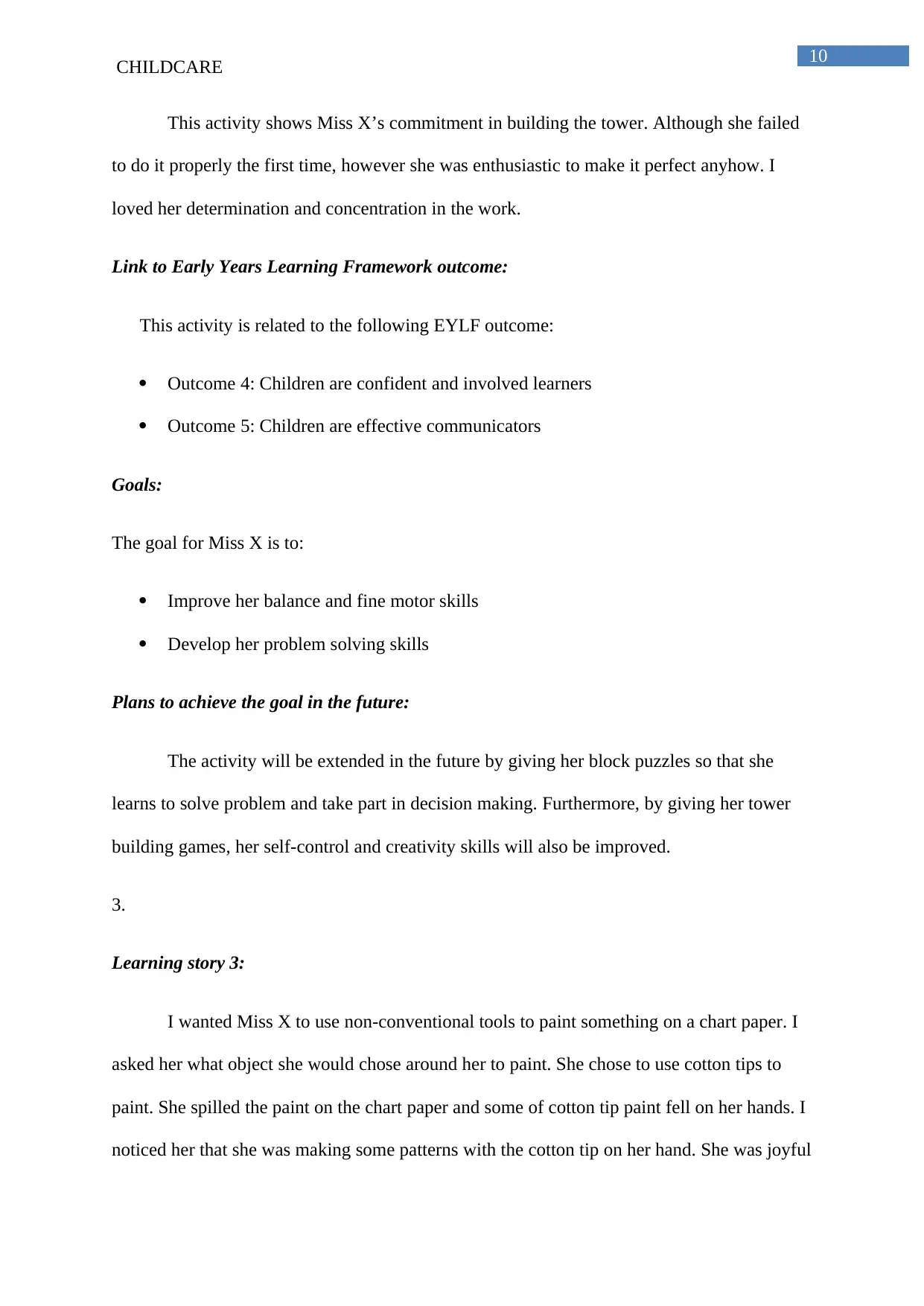
10
CHILDCARE
This activity shows Miss X’s commitment in building the tower. Although she failed
to do it properly the first time, however she was enthusiastic to make it perfect anyhow. I
loved her determination and concentration in the work.
Link to Early Years Learning Framework outcome:
This activity is related to the following EYLF outcome:
Outcome 4: Children are confident and involved learners
Outcome 5: Children are effective communicators
Goals:
The goal for Miss X is to:
Improve her balance and fine motor skills
Develop her problem solving skills
Plans to achieve the goal in the future:
The activity will be extended in the future by giving her block puzzles so that she
learns to solve problem and take part in decision making. Furthermore, by giving her tower
building games, her self-control and creativity skills will also be improved.
3.
Learning story 3:
I wanted Miss X to use non-conventional tools to paint something on a chart paper. I
asked her what object she would chose around her to paint. She chose to use cotton tips to
paint. She spilled the paint on the chart paper and some of cotton tip paint fell on her hands. I
noticed her that she was making some patterns with the cotton tip on her hand. She was joyful
CHILDCARE
This activity shows Miss X’s commitment in building the tower. Although she failed
to do it properly the first time, however she was enthusiastic to make it perfect anyhow. I
loved her determination and concentration in the work.
Link to Early Years Learning Framework outcome:
This activity is related to the following EYLF outcome:
Outcome 4: Children are confident and involved learners
Outcome 5: Children are effective communicators
Goals:
The goal for Miss X is to:
Improve her balance and fine motor skills
Develop her problem solving skills
Plans to achieve the goal in the future:
The activity will be extended in the future by giving her block puzzles so that she
learns to solve problem and take part in decision making. Furthermore, by giving her tower
building games, her self-control and creativity skills will also be improved.
3.
Learning story 3:
I wanted Miss X to use non-conventional tools to paint something on a chart paper. I
asked her what object she would chose around her to paint. She chose to use cotton tips to
paint. She spilled the paint on the chart paper and some of cotton tip paint fell on her hands. I
noticed her that she was making some patterns with the cotton tip on her hand. She was joyful

11
CHILDCARE
and asked me how her tattoo is looking. Fascinated by new art, she also asked other children
to make tattoo on their hands.
Interpretation:
Through this experience, I saw a new element of Miss X’s skill and that by mistake
she was making connection that the cotton tips paintings on her hand are actually a form of
art. Her enthusiasm to share this new discovery with others was also encouraging and
satisfying to see.
Link to Early Years Learning Framework outcome:
This is linked to EYLF outcome 4 because she developed disposition for learning
through her creativity and she transferred what she learnt too.
Goals:
The goals for learning of Miss X are:
To make her explore further experiences like body sensory exploration
To make the child understand that creativity can be shown by other means too
Plans to achieve the goal in the future:
The plan for the future is to engage Miss X in new activities so that she can
understand sensation and texture of different things. For example, she can be asked to use
other objects and classify them according to texture.
Work samples:
Observation:
CHILDCARE
and asked me how her tattoo is looking. Fascinated by new art, she also asked other children
to make tattoo on their hands.
Interpretation:
Through this experience, I saw a new element of Miss X’s skill and that by mistake
she was making connection that the cotton tips paintings on her hand are actually a form of
art. Her enthusiasm to share this new discovery with others was also encouraging and
satisfying to see.
Link to Early Years Learning Framework outcome:
This is linked to EYLF outcome 4 because she developed disposition for learning
through her creativity and she transferred what she learnt too.
Goals:
The goals for learning of Miss X are:
To make her explore further experiences like body sensory exploration
To make the child understand that creativity can be shown by other means too
Plans to achieve the goal in the future:
The plan for the future is to engage Miss X in new activities so that she can
understand sensation and texture of different things. For example, she can be asked to use
other objects and classify them according to texture.
Work samples:
Observation:
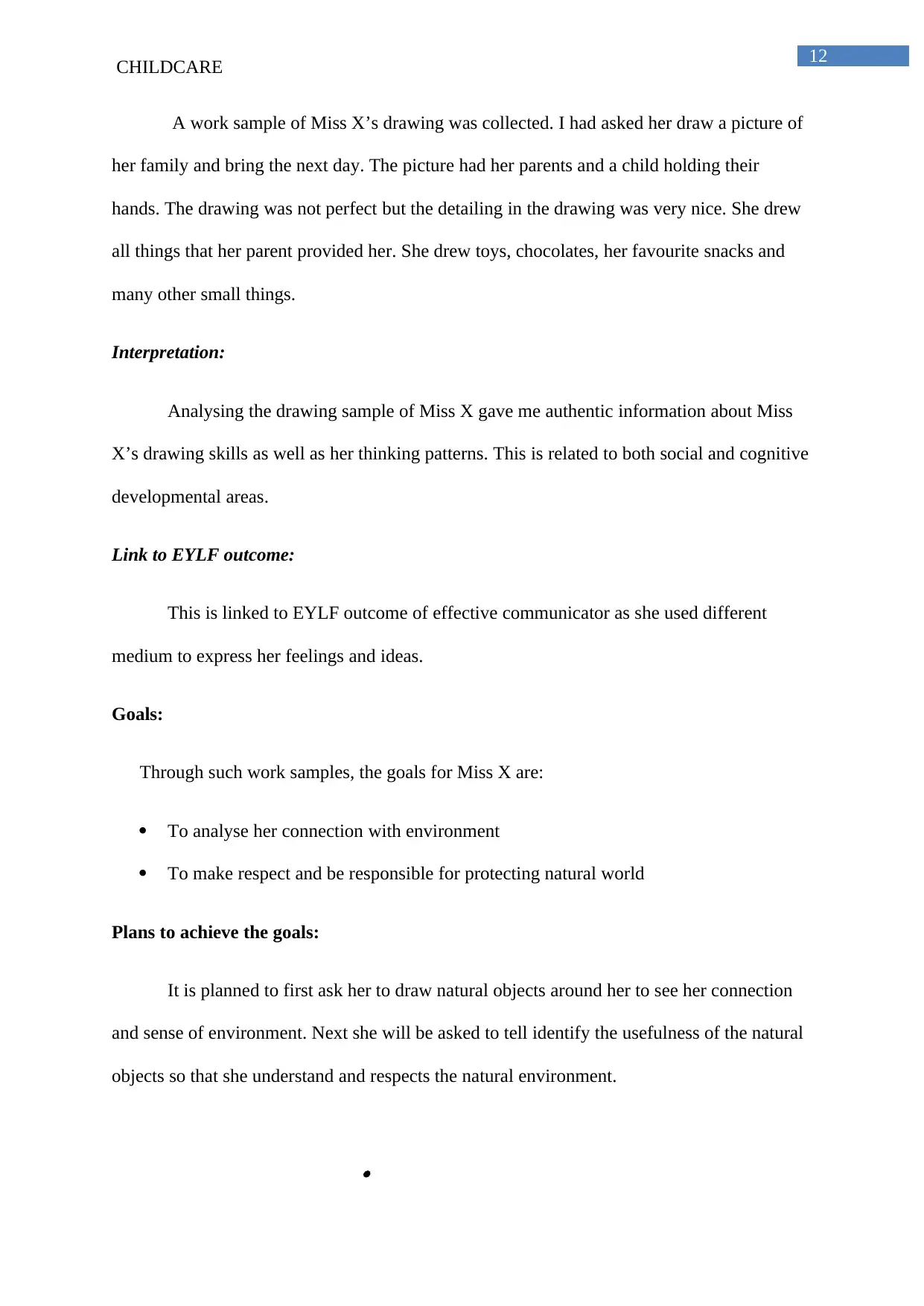
12
CHILDCARE
A work sample of Miss X’s drawing was collected. I had asked her draw a picture of
her family and bring the next day. The picture had her parents and a child holding their
hands. The drawing was not perfect but the detailing in the drawing was very nice. She drew
all things that her parent provided her. She drew toys, chocolates, her favourite snacks and
many other small things.
Interpretation:
Analysing the drawing sample of Miss X gave me authentic information about Miss
X’s drawing skills as well as her thinking patterns. This is related to both social and cognitive
developmental areas.
Link to EYLF outcome:
This is linked to EYLF outcome of effective communicator as she used different
medium to express her feelings and ideas.
Goals:
Through such work samples, the goals for Miss X are:
To analyse her connection with environment
To make respect and be responsible for protecting natural world
Plans to achieve the goals:
It is planned to first ask her to draw natural objects around her to see her connection
and sense of environment. Next she will be asked to tell identify the usefulness of the natural
objects so that she understand and respects the natural environment.
CHILDCARE
A work sample of Miss X’s drawing was collected. I had asked her draw a picture of
her family and bring the next day. The picture had her parents and a child holding their
hands. The drawing was not perfect but the detailing in the drawing was very nice. She drew
all things that her parent provided her. She drew toys, chocolates, her favourite snacks and
many other small things.
Interpretation:
Analysing the drawing sample of Miss X gave me authentic information about Miss
X’s drawing skills as well as her thinking patterns. This is related to both social and cognitive
developmental areas.
Link to EYLF outcome:
This is linked to EYLF outcome of effective communicator as she used different
medium to express her feelings and ideas.
Goals:
Through such work samples, the goals for Miss X are:
To analyse her connection with environment
To make respect and be responsible for protecting natural world
Plans to achieve the goals:
It is planned to first ask her to draw natural objects around her to see her connection
and sense of environment. Next she will be asked to tell identify the usefulness of the natural
objects so that she understand and respects the natural environment.
Paraphrase This Document
Need a fresh take? Get an instant paraphrase of this document with our AI Paraphraser

13
CHILDCARE
CHILDCARE
1 out of 14
Your All-in-One AI-Powered Toolkit for Academic Success.
+13062052269
info@desklib.com
Available 24*7 on WhatsApp / Email
![[object Object]](/_next/static/media/star-bottom.7253800d.svg)
Unlock your academic potential
© 2024 | Zucol Services PVT LTD | All rights reserved.